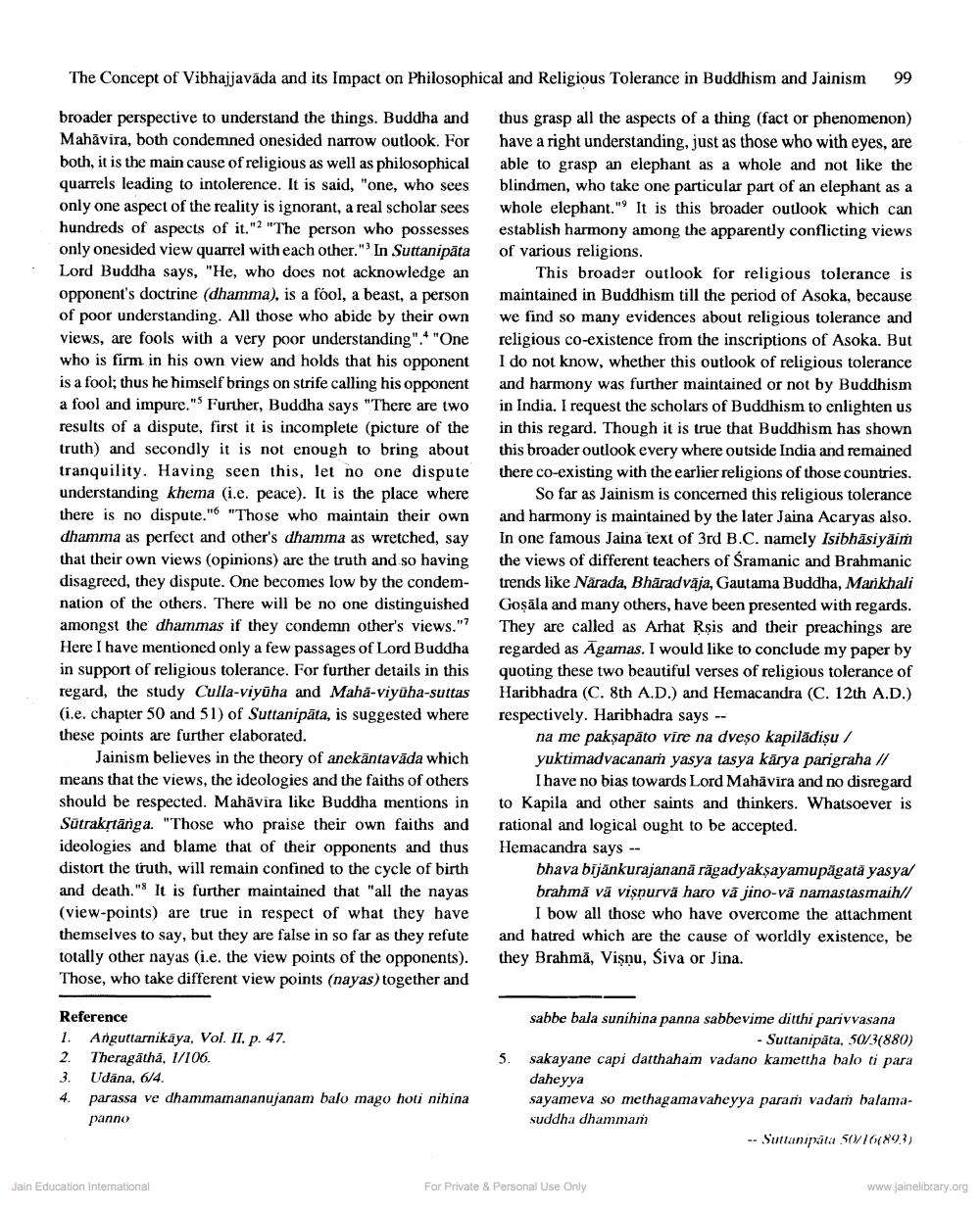________________
The Concept of Vibhajjavāda and its Impact on Philosophical and Religious Tolerance in Buddhism and Jainism
99
broader perspective to understand the things. Buddha and Mahāvira, both condemned onesided narrow outlook. For both, it is the main cause of religious as well as philosophical quarrels leading to intolerence. It is said, "one, who sees only one aspect of the reality is ignorant, a real scholar sees hundreds of aspects of it."2 "The person who possesses only onesided view quarrel with each other." ' In Suttanipäta Lord Buddha says, "He, who does not acknowledge an opponent's doctrine (dhamma), is a fool, a beast, a person of poor understanding. All those who abide by their own views, are fools with a very poor understanding". "One who is firm in his own view and holds that his opponent is a fool; thus he himself brings on strife calling his opponent a fool and impure."' Further, Buddha says "There are two results of a dispute, first it is incomplete (picture of the truth) and secondly it is not enough to bring about tranquility. Having seen this, let no one dispute understanding khema (i.e. peace). It is the place where there is no dispute." "Those who maintain their own dhamma as perfect and other's dhamma as wretched, say that their own views (opinions) are the truth and so having disagreed, they dispute. One becomes low by the condemnation of the others. There will be no one distinguished amongst the dhammas if they condemn other's views." Here I have mentioned only a few passages of Lord Buddha in support of religious tolerance. For further details in this regard, the study Culla-viyūha and Maha-viyüha-suttas (i.e. chapter 50 and 51) of Suttanipāta, is suggested where these points are further elaborated.
Jainism believes in the theory of anekantavāda which means that the views, the ideologies and the faiths of others should be respected. Mahavira like Buddha mentions in Sutrakrtānga. "Those who praise their own faiths and ideologies and blame that of their opponents and thus distort the truth, will remain confined to the cycle of birth and death." It is further maintained that "all the nayas (view-points) are true in respect of what they have themselves to say, but they are false in so far as they refute totally other nayas (i.e. the view points of the opponents). Those, who take different view points (nayas) together and
thus grasp all the aspects of a thing (fact or phenomenon) have a right understanding, just as those who with eyes, are able to grasp an elephant as a whole and not like the blindmen, who take one particular part of an elephant as a whole elephant." It is this broader outlook which can establish harmony among the apparently conflicting views of various religions.
This broader outlook for religious tolerance is maintained in Buddhism till the period of Asoka, because we find so many evidences about religious tolerance and religious co-existence from the inscriptions of Asoka. But I do not know, whether this outlook of religious tolerance and harmony was further maintained or not by Buddhism in India. I request the scholars of Buddhism to enlighten us in this regard. Though it is true that Buddhism has shown this broader outlook every where outside India and remained there co-existing with the earlier religions of those countries.
So far as Jainism is concerned this religious tolerance and harmony is maintained by the later Jaina Acaryas also. In one famous Jaina text of 3rd B.C. namely Isibhāsiyăim the views of different teachers of Sramanic and Brahmanic trends like Narada, Bhāradvāja, Gautama Buddha, Markhali Goşāla and many others, have been presented with regards. They are called as Arhat Rsis and their preachings are regarded as Agamas. I would like to conclude my paper by quoting these two beautiful verses of religious tolerance of Haribhadra (C. 8th A.D.) and Hemacandra (C. 12th A.D.) respectively. Haribhadra says --
na me pakşapāto vire na dveşo kapiladişu / yuktimadvacanar yasya tasya karya parigraha //
I have no bias towards Lord Mahävira and no disregard to Kapila and other saints and thinkers. Whatsoever is rational and logical ought to be accepted. Hemacandra says -
bhava bijankurajanana rāgadyakşayamupagata yasya brahmă vă visnurvă haro va jino-vä namastasmaih//
I bow all those who have overcome the attachment and hatred which are the cause of worldly existence, be they Brahmä, Vişnu, Siva or Jina.
Reference 1. Anguttarnikāya, Vol. II, p. 47. 2. Theragātha, 1/106. 3. Udāna, 6/4. 4. parassa ve dhammamananujanam balo mago hoti nihina
panno
sabbe bala sunihina panna sabbevime ditthi parivvasana
- Suttanipāta, 50/3(880) sakayane capi datthaham vadano kamettha balo ti para daheyya sayameva so methagamavaheyya para vadam balamasuddha dhammam
-- Suttanipata 50161893)
Jain Education International
For Private & Personal Use Only
www.jainelibrary.org




